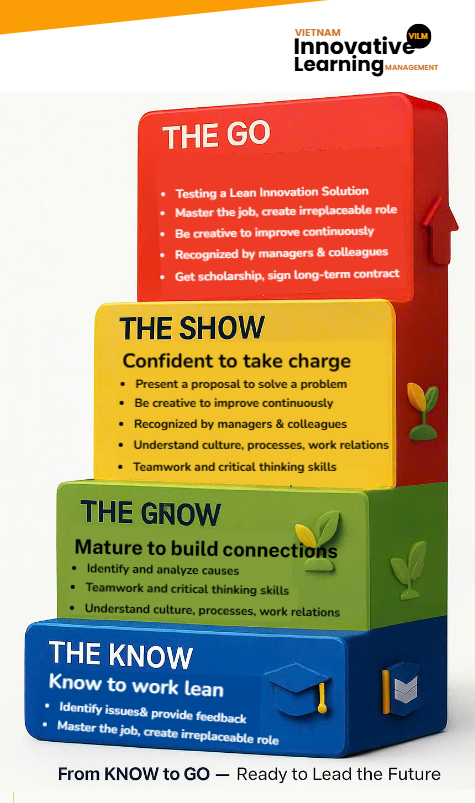S2M – BRIDGING THE GAP BETWEEN SCHOOLS AND THE JOB MARKET
- WE@WORK

- Oct 9
- 7 min read
The rate of graduates working in fields unrelated to their studies in Vietnam has reached an alarming level—over 60% in some majors. Meanwhile, many companies struggle to find skilled workers who meet real-world demands. This paradox not only wastes students’ time and education costs but also forces businesses to spend heavily on recruitment, retraining, and dealing with high staff turnover. The gap between schools and the job market has thus become an urgent challenge that demands a solution.
Graduates Working Outside Their Field of Study
Recent surveys indicate that a significant portion of graduates are unable to find jobs in their field of study or are forced to take positions outside their major. This creates a paradox in Vietnam, where there is both an oversupply of university graduates and a shortage of workers with the right skills.
According to research by Dr. Trần Quang Tuyến, PhD candidate Vũ Bích Ngọc, and Dr. Vũ Văn Hưởng, presented at the seminar “Graduates Working Outside Their Field: Business and Management Graduates in Vietnam” at the International School – Vietnam National University, the average rate of graduates working outside their field across all majors is 21.43%. Broken down by discipline: Engineering, Technology, Architecture & Construction – 31.6%; Humanities & Arts – 63%; Natural Sciences, Mathematics & IT – 60.6%; Agriculture, Forestry, Fisheries & Veterinary – 67%[1]. In fact, between 2021 and 2023, only 22–37% of Hanoi Law University graduates found jobs in their field after graduation.[2]

At the same time, companies report a shortage of skilled workers, especially for roles that require a combination of technical expertise, foreign language proficiency, workflow knowledge, and organizational culture fit.
Even when positions are filled, many businesses face high turnover within the first 6–12 months. Frequent staff changes not only drive up internal training costs but also directly impact productivity and operational stability.
THE SCHOOL–MARKET GAP CHALLENGE

Challenges for Students
Lack of practical experience: Much of the theoretical knowledge cannot be applied to real work.
Unclear career path: Many fall into a “trial-and-error” cycle after graduation.
Skills gap: Students often lack deep expertise, understanding of workplace culture, rules, and operational processes.
Formal internships: Many are unpaid or offer little motivation for long-term commitment.
Misguided orientation: After 3–4 years of study,
many students still work outside their field or drop out.High turnover: Low employment rates and early job changes due to poor job fit.
Challenges for Schools
Outdated curricula: Training programs lag behind market needs.
Focus on theory over practice: Emphasis is on “teach–learn–test” rather than “experience–practice–problem-solving.”
Classroom-based learning: Lacks real-world context.
Underutilized resources: Expensive equipment and labs provide few practical opportunities for students.
Limited industry collaboration impact: Even with diverse partnerships and guest practitioners, outcomes often don’t match market demands.
Training results insufficient: Graduates struggle to secure jobs in their field.
Challenges for Businesses
Finding talent: Hard to locate candidates with both foundational knowledge and practical skills.
High training costs: Must retrain employees or risk hiring the wrong people.
Ineffective support investments: Financial contributions to schools often don’t result in suitable hires.
Expensive training tech: VR/AR investments do not guarantee real productivity.
Assessment gaps: Exam results often fail to reflect actual job skills and workplace attitudes.
Inconsistent recruitment criteria: Hiring expectations may be subjective or unrealistic.
Supply-demand mismatch: High turnover and a workforce unable to meet growing demand.
Challenges for the Broader Market
Graduate oversupply vs. skill shortage: Plenty of degree holders, but not enough quality talent.
Widening labor gap: Supply cannot keep up with demand, creating systemic pressure.
Strategic-execution gap: Common across industries due to workforce mismatches.
Lack of data and reporting: Difficult to evaluate and implement effective policies.
Need for breakthrough solutions: Approaches should focus on measurable outcomes, sustainable competencies, and market adaptability.
S2M – THE LEAN LEARNING FACTORY: CONNECTING SCHOOLS AND THE JOB MARKET

The solution proposed by Respect Vietnam (RVN) to address the “study one way, work another” problem is built on a simple principle: training must start with the specific needs of the market. Instead of offering generic programs, RVN works directly with both schools and businesses to clarify the real-world requirements students need to meet immediately after graduation.
Unlike the traditional “three-way” collaboration programs – involving the government, educational institutions, and businesses – which mainly focus on general policies or mechanisms to bridge schools and the labor market, S2M takes a much more practical and specific approach.
The program starts by clarifying the actual needs of businesses, identifying the skills and competencies they lack and require in future employees. Based on this information, S2M designs training and capacity-building activities for students, equipping them with the exact skills and mindset that the labor market demands. As a result, students not only enhance their adaptability but also meet the real needs of employers as they enter the workforce.
THE REACH OF S2M AND THE SUPPORT OF REPUTABLE ORGANIZATIONS AND EXPERTS
Respect Vietnam’s labor-market-linked training initiative is currently being implemented in several provinces, including Phú Thọ. The model has received strong support from universities and vocational colleges such as Hanoi University of Science and Technology, Đại Nam University, Hanoi University of Industry, Hùng Vương University, Phú Thọ Vocational College, and others. Widespread implementation not only gives students earlier access to real-world experience but also provides a solid foundation for businesses to find quality talent, helping to bridge the gap between the classroom and the workplace.
The Support of Phú Thọ Provincial People’s Committee for the VILM2030 Initiative (Including the S2M Project)

On May 29, 2025, at the Phú Thọ Provincial People’s Committee, the VILM2030 Initiative presented its content and proposals to representatives of the provincial leadership, the Office of the People’s Committee, heads of the Departments of Home Affairs and Education & Training, as well as leaders from universities and colleges in the province. The Phú Thọ Provincial People’s Committee recognized the initiative’s significant impact on workforce development in both the public and private sectors and agreed to implement it, committing full support for the pilot rollout of the project in the province.
Signing Ceremony of the Memorandum of Understanding Between Respect Vietnam & Hùng Vương University

On September 24, 2025, Hùng Vương University held a signing ceremony to formalize an agreement with Respect Vietnam Co., Ltd. for the implementation of the S2M project. The initiative aims to support training and skill development aligned with real-world business requirements, based on the Lean Learning Factory model.
Mr. Đỗ Khắc Thanh, Rector of Hùng Vương University, remarked: “I see this solution as highly practical and essential for students as they begin working in businesses.”
Signing Ceremony of the Memorandum of Understanding Between Respect Vietnam & Phú Thọ Vocational College

On the same day, September 24, 2025, Phú Thọ Vocational College held a signing ceremony to formalize an agreement with Respect Vietnam Co., Ltd.
During the meeting, Ms. Cao Thị Thanh Hòa, Head of Admissions and Career Services, commented: “We have long been concerned about two issues regarding student employment: (i) there is little distinction between trained and untrained students, making it hard to assess their true value in the workplace; (ii) the proportion of students who stay with a company for more than two years is very low. I hope the S2M project will help address these challenges.”
Cam kết đồng hành của các trường đại học tại dự án S2M

Mr. Lê Đắc Sơn, Chairman of the Board of Đại Nam University, stated: “Đại Nam University agrees with the approach of using business requirements as the training outcome. We look forward to the active involvement of companies throughout the university’s training process.”
Mr. Nguyễn Ngọc Long, Vice Rector of Hanoi Polytechnic Vocational College, added: “We have a relatively high rate of graduates working outside their field. Through this program, we hope students will better understand their own career needs and meet employers’ requirements to start working immediately in the right field.”

Ms. Phạm Thanh Huyền, Head of Student Affairs at Hanoi University of Science and Technology, stated: “Even though we carefully prepare students for internships, we still frequently have to deal with issues such as disciplinary violations or breaches of workplace safety. I hope Respect Vietnam’s Lean Training program can help address these challenges.”

Mr. Phan Trọng Tùng, Deputy Director of the Employment and Entrepreneurship Training Survey Center at Hanoi University of Business and Technology, shared: “We have collaborated with many projects and businesses, and I find the S2M initiative to be highly innovative. I fully support its implementation.”
Ms. Trần Ánh Phương, Deputy Head of the General Affairs Department at the School of Economics – Hanoi University of Industry, added: “I hope the initiative can bring practical value to students, the university, and society as a whole.”
CALL TO ACTION
Respect Vietnam believes that bridging the gap between education and employment cannot be the effort of a single party. Students need to actively participate in practical programs to discover their own capabilities and prepare for integration into the workforce. Businesses must collaborate with schools, set clear criteria, and support the training process from the very beginning. Universities and colleges should expand partnerships, align curricula with market needs, and innovate teaching methods.
When all three links work together, RVN’s Lean Learning model will not only help students secure jobs in their field and provide businesses with the right talent, but also contribute to developing a generation of high-quality Vietnamese workers ready to step confidently into the global market.
To learn more about the Lean Learning program and explore collaboration opportunities between schools, businesses, and students, please contact:
Respect Việt Nam
Email: info@respectvn.com
Hotline: 0888673222
Website: https://www.respectvn.com/s2m

S2M “From School to Market” is the first initiative in Vietnam to apply innovative training mindsets and technology to focus on workforce quality from school to workplace. The project is part of the VILM2030 Program – the Vietnam Innovation in Learning & Management Initiative through 2030.
S2M is designed as an ecosystem for training, testing, and talent development during students’ internship and probation periods, involving four key stakeholders: students, schools, businesses, and society. The core differentiators of S2M include the following.
It goes beyond classroom learning, challenging students to apply their skills directly in real-world environments.
Students are able to evaluate their own competencies, be assigned suitable roles, and receive skill coaching during internships and probation.
The program uses real-world data and reports to allow businesses, schools, and students to make informed decisions together.
S2M is currently the only program in Vietnam emphasizing workforce quality over quantity, aiming to develop sustainable competencies that adapt to market needs.

There are no great organizations. There are only great people who make great organizations"
-----------
Respect Vietnam prepares purpose-driven leaders & people-centric organizations In the face of the fast-changing world of work
-----------
RESPECT VIETNAM LTD CO.
Fanpage: RespectVN
Website: respectvn.com
Linkedin: vn.linkedin.com/company/respect-vietnam
Address: No. 66 Lane 102 Street Truong Chinh, District Dong Da, Hanoi
Email: info@respectvn.com
Hotline: 0888673222








Thanks a lot for providing information, and we are also providing information for buying authority plot in Noida As we help in finding the best residential, commercial and authority plots in Noida Extension, if you are interested then you can call on the given number-7289000808.https://www.plotsinnoida.com/residential-plots-in-noida-extension.php
Thank you for the detailed information! We offer you some of the best luxury villas in Noida and all major luxury cities at the best deals. If you are interested, please call the following number- 9560787473. https://www.villasinnoida.com/